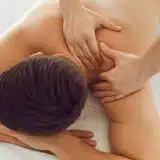Massage for TMJ Dysfunction
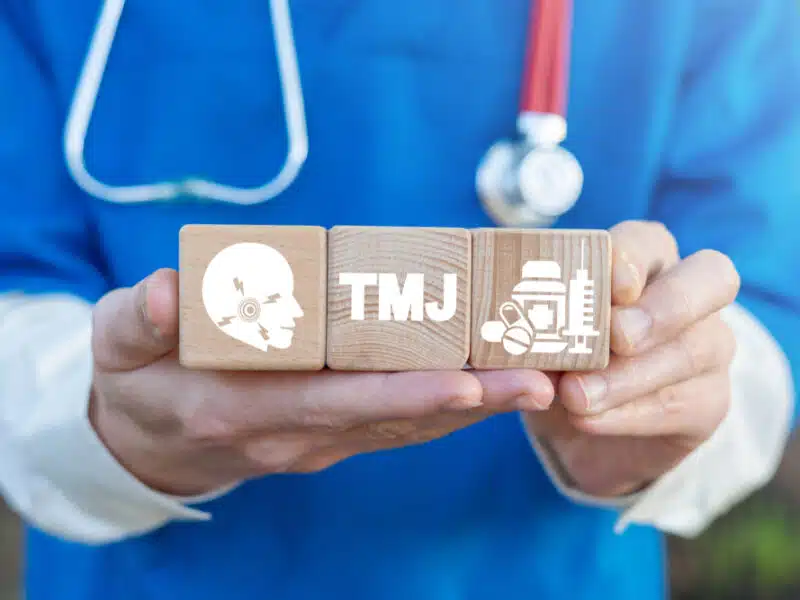
Unlocking Relief: Effective Massage Techniques for TMJ Dysfunction
What is Massage 18th Jul, 2023
Temporomandibular joint problems, often known as TMJ disorders, are a widespread and annoying problem that impacts a lot of people. TMJ problems are a common issue that impacts over 10 million Americans, according to estimates. TMJ diseases result from uncomfortable and irritated muscles around the temporomandibular joint, which links the jawbone to the skull.
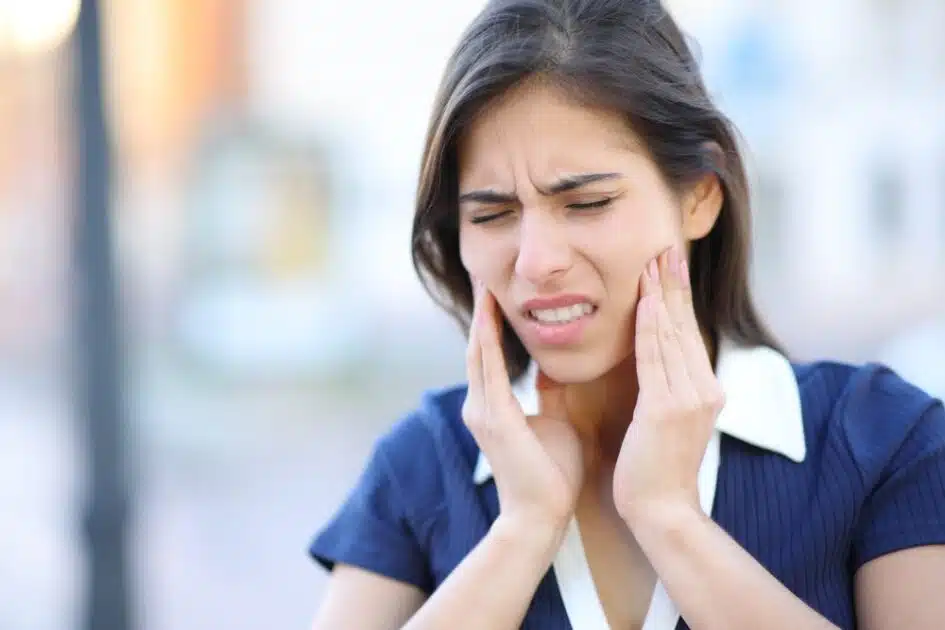
Finding lasting treatment for TMJ requires an understanding of its causes. Teeth clenching or grinding (bruxism), arthritis, jaw trauma, or even genetic susceptibility can all lead to TMJ discomfort. TMJ problems can include discomfort or soreness in the jaw, temporomandibular joints, or around the ear, trouble eating, pain, or locking of the jaw joint, which makes it difficult to fully open or close the mouth.
TMJ massage is one such treatment that appears to be effective in bringing about comfort. Individuals may actively manage their TMJ discomfort and enhance their general well-being by learning and using particular self-massage techniques.
The Principles of TMJ
TMJ issues can be a difficult disease to understand since it can be hard to pinpoint the specific reason. TMJ issues can, however, be triggered by a variety of reasons.
Effective treatment requires an understanding of these characteristics and the ability to identify the signs. Knowing when to seek expert assistance also guarantees accurate diagnosis and suitable therapy.
TMJ Disorders: Contributing Factors
Due to the complexity of the illness, it might be challenging to identify a single cause of TMJ issues.
However, a number of variables, such as the following, are known to contribute to the emergence of TMJ disorders:
Osteoarthritis a Rheumatoid Arthritis
Are two types of arthritis that can damage the temporomandibular joint and exacerbate TMJ issues.
Jaw Damage
TMJ discomfort and dysfunction can be brought on by trauma or damage to the jaw, such as a direct hit or whiplash.
Teeth Clenching or Grinding (Bruxism)
Repetitive jaw muscle tension and TMJ issues can result from teeth clenching or grinding, which is frequently linked to stress or sleep disturbances.
Malocclusion
When the teeth or jaw are out of place, this condition is referred to as malocclusion and can cause pain and discomfort in the temporomandibular joint (TMJ).
Genetic Predisposition
Some people may be genetically predisposed to TMJ issues, making them more likely to experience jaw discomfort and dysfunction.
Although these factors may lead to TMJ issues, it’s crucial to remember that everyone will experience these things differently. Making a successful treatment plan might benefit from identifying the unique circumstances that are at play in your instance.
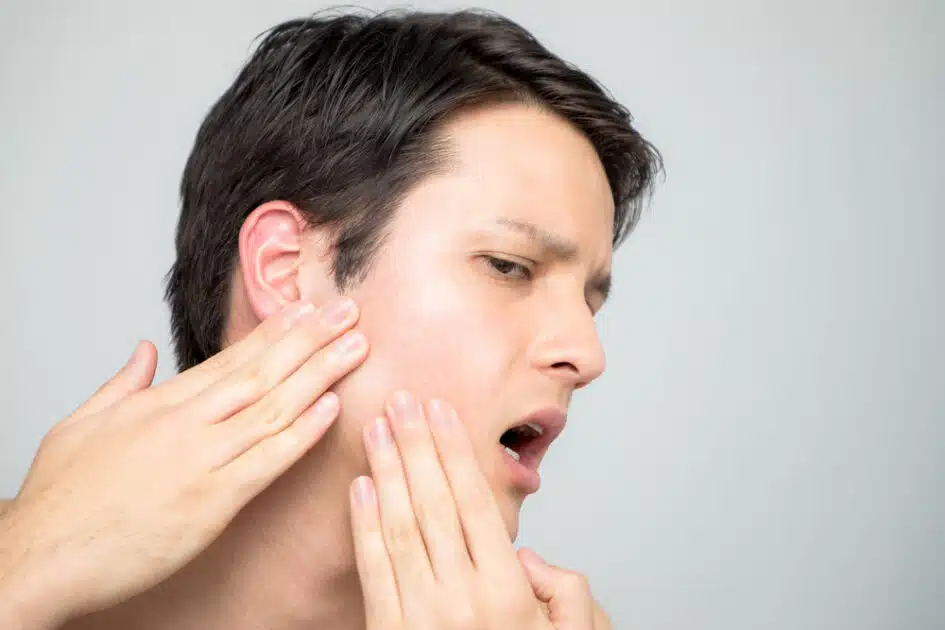
Identifying Symptoms: Pain, Tenderness, Chewing Difficulties, and More
Recognizing the symptoms associated with TMJ disorders is essential for early intervention and appropriate management. The following signs and symptoms may indicate the presence of TMJ disorders:
Tenderness or Pain in the Jaw
Temporomandibular joints (placed in front of the ears), or adjacent regions such as the temples or cheeks.
Difficulty or Pain While Chewing
Pain or discomfort felt while biting, chewing, or expanding the mouth wide. When moving the jaw, this may be accompanied by a clicking or popping sound.
Jaw Locking
The jaw joint may periodically lock, making it difficult to fully open or close the mouth.
Facial Fatigue
Even with minor activity, the muscles involved in eating may feel worn or exhausted.
Headaches:
TMJ issues can produce persistent headaches, which are typically similar to tension headaches, as well as earaches or a sense of fullness in the ears.
Neck and Shoulder Pain:
The discomfort caused by TMJ issues can go beyond the mouth, resulting in neck and shoulder pain.
Dental Issue:
TMJ issues can cause tooth misalignment or changes in how the upper and lower teeth fit together, potentially leading to dental difficulties.
If you have persistent discomfort or soreness in your jaw, or if you have difficulty moving your jaw, you should see a dentist or doctor for an accurate assessment and diagnosis.
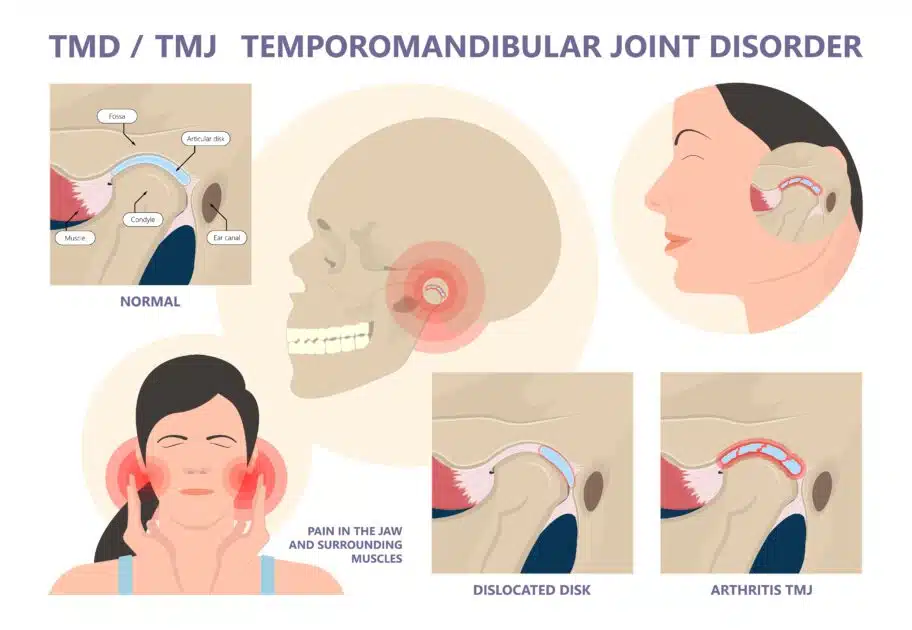
When to Consult a Dentist or Doctor
If your TMJ discomfort or symptoms persist or increase after self-care, it’s critical to get expert help. Persistent or worsening symptoms may suggest the need for further testing and professional care.
Professional assistance is required if you have major limits in jaw mobility, such as the inability to completely open or close your mouth. Jaw mobility issues can have a major influence on your quality of life, and a healthcare expert can assist in identifying the underlying reasons and providing suitable treatment choices.
TMJ pain and discomfort can interfere with daily activities such as eating, speaking, and sleeping. If your TMJ problems are interfering with your ability to perform crucial duties, you should see a doctor. They can assess the severity of your ailment and offer appropriate measures to help you live a better life.
If you feel that teeth grinding or clenching (bruxism) is causing your TMJ problems, you should see a dentist. They can do a complete examination, evaluate your oral health, and shed light on the connection between bruxism and TMJ issues. In addition, the dentist can suggest appropriate treatment choices to address the underlying reason.
Consultation with a dentist is essential if you observe changes in your bite, teeth alignment, or other dental concerns linked with your TMJ disease. Dentists are trained to diagnose and treat dental problems associated with TMJ disorders. They can explain how these dental issues may be contributing to your jaw discomfort and propose suitable treatments to restore oral health and relieve TMJ symptoms.
Recommended:
Can Massage Help Arthritis
Kneading Massage for TMJ
TMJ kneading massage is a method that concentrates on the masseter muscles, which are important in jaw movement. You can assist relieve TMJ discomfort and induce relaxation by using circular motions and mild pressure on these muscles.
Location and Function
To start the TMJ kneading massage, find the masseter muscles in your lower jaw. These muscles are located slightly below your teeth and below your cheekbones. You may find them by beginning at the corner of your mouth and feeling for a flat plane of bone with your fingertips. The masseter muscles are located in this flat plane.
The masseter muscles are targeted to reduce tension and promote relaxation in the jaw region. In those with TMJ issues, the masseter muscles are frequently overused and can become stiff and uncomfortable. By kneading these muscles, you may increase circulation, alleviate tension, and promote lymphatic function, which assists in the evacuation of waste products from the muscles.
Step-by-Step Instructions on Using Circular Motion for Pain Relief
Once you’ve discovered the masseter muscles, you may begin the TMJ kneading massage by following the steps below:
1. Position your fingers: Gently press two or three fingers on the masseter muscles. It is critical, to begin with light pressure and gradually raise it to your comfort level.
2. Circular Motion: Begin by moving your fingers in a circular manner on the masseter muscles. The circular motion should be mild, continuous, and smooth. Consider kneading dough or massaging a sore muscle.
3. Warm up the Muscles: Continue the circular motion while warming up the muscles. This promotes relaxation and reduces muscular tension by increasing blood flow to the region. As blood circulation increases, you may feel warmth or a small tingling feeling.
4. Experiment with different places and angles: When massaging the masseter muscles, you can try different areas and angles. Certain areas may be more touchy or sensitive to certain people than others. You can find the places that give the most relief by investigating different regions.
5. Duration: Continue the kneading massage for a few minutes, or until you feel some alleviation. Remember to listen to your body and modify the pressure and time as needed.
Trying Various Methods and Areas
The degree of TMJ discomfort and how each person reacts to massage treatments might differ. It’s crucial to try out various strategies and locales to determine what works best for you. During your TMJ kneading massage, try the following extra methods and areas:
1. Try massaging your jaw with your full hand: rather than just a few fingers by utilizing this technique. Apply circular motions to the masseter muscles by placing a gentle palm on the side of your face.
2. Side-to-side motion: You may also use moderate side-to-side motions during the massage in addition to circular motions. This variant can promote a deeper state of relaxation by focusing on certain masseter muscle fibers.
3. Other jaw muscles: In addition to massaging the masseter muscles, which are the main emphasis, you may also try massaging the temporalis muscles, which are situated on the sides of your head next to your temples. It may be possible to relieve tension over the entire jaw area by experimenting with various places.
It’s important to keep in mind that the TMJ kneading massage works best when you locate the techniques and places that bring you the greatest relief. You may tailor the massage to your particular requirements by experimenting and paying attention to your body, but it can take some trial and error.
Massage with TMJ friction
A treatment known as TMJ friction massage applies pressure to the affected area to reduce TMJ discomfort and encourage muscular relaxation.
You can obtain relief from stress and discomfort in the jaw area by using the proper pressure and focusing on particular places.
Pressure for Relief: The Value of Proper Implementation
The efficiency of TMJ friction massage depends on the amount of pressure used. The pressure must be just right to relieve the pain while being soft enough to prevent aggravating it. It’s crucial to pay attention to your body and change the pressure as needed to be comfortable.
While applying inadequate pressure might not have the intended therapeutic impact, applying too much pressure might result in increased discomfort and muscular strain. To discover the balance that is most comfortable for you during the massage, experiment with various pressure levels.
Locating the Mandible Muscle at the Correct Place
The main area of focus of the TMJ friction massage is the mandible muscle, sometimes referred to as the lower jaw muscle. Follow these steps to find this muscle:
1. Your index finger should be placed on the area of your jaw below the masseter muscles.
2. Along the jawline, there is a strong muscular band that you can feel. The mandible muscle is seen here.
3. The TMJ friction massage can begin once the mandible muscle has been located.
The Effectiveness of TMJ Massage
TMJ massage has demonstrated a lot of potential for relieving TMJ pain and discomfort. The ability to do massage at home encourages people to actively participate in their own self-care and TMJ condition management. People can benefit from focused jaw muscle manipulation, enhanced blood circulation, and relaxation by learning and using the methods.
Finding the proper areas and using the optimum pressure is crucial for a successful TMJ massage. It’s crucial to investigate and experiment with various approaches and locations to see what works best for individual requirements because each person’s experience with TMJ issues may vary.
Finding the correct spots and pressure that bring comfort is vital, whether it’s the kneading massage targeting the masseter muscles or the friction massage on the mandible muscle.
While at-home TMJ massage can be beneficial for many people, chronic discomfort or severe symptoms may necessitate expert help. If the pain persists or increases despite self-care attempts, it is best to seek the advice of a dentist or doctor. They may provide a thorough examination, identify appropriate treatment alternatives, and suggest complementary therapies to TMJ massage procedures. Seeking expert help ensures thorough care and the best outcomes in the treatment of TMJ issues.
TMJD and its Effects on the Jaw, Neck, Face, and Teeth
TMJD, or temporomandibular joint disease, can have a wide-ranging influence on the body. The temporomandibular joint connects the jawbone to the skull, and dysfunction in this joint can cause a variety of symptoms. TMJD is most typically associated with jaw discomfort, although it can also impact the neck, face, and teeth. TMJD patients may suffer muscle discomfort during chewing, swallowing, or speaking.
Another typical symptom is restricted jaw mobility, such as difficulties opening or shutting the mouth completely. TMJD can also produce clicking, popping, or cracking noises in the jaw, dental concerns such as misaligned teeth, neck, scalp, and shoulder discomfort, recurrent headaches, and even symptoms such as ear pain, ringing, or itch. The widespread impact of TMJD emphasizes the need for effective therapies that address these interrelated issues.
The Benefits of Massage
Massage has emerged as a viable therapy technique for TMJD and its related symptoms. Numerous studies have found massage to be useful in delivering alleviation and enhancing the well-being of people with TMJD. A 2021 study revealed that conservative manual treatments, such as massage, are significantly useful in reducing TMJD-related discomfort and increasing jaw joint range of motion.
The study found that massage therapies resulted in substantial improvements in pain alleviation and maximum mouth opening. Registered massage therapists that include TMJ exercises in their treatment programs have also had beneficial results with their clients.
Massage treatment not only treats the physical part of TMJD, but it also provides relaxation and stress reduction, both of which are important in managing this illness. Massage is a useful component in the therapy of TMJD due to its comprehensive advantages.
Recommended:
The Magic of Indian Head Massage
FAQs
Are massages good for TMJ?
Yes, they can alleviate symptoms.
What kind of massage is good for TMJ?
Targeted massages on jaw muscles, like myofascial release or trigger point therapy.
How do you massage yourself for TMJ?
Use your fingers to gently massage the jaw muscles, focusing on areas of tension.
Where is the pressure point for TMJ?
Located in the masseter muscle, just in front of the ear where the jaw meets the skull.
How can I relieve TMJ fast?
Anti-inflammatory medications, heat or ice applications, gentle jaw exercises, or wearing a mouth guard at night.
The Bottom Line
Massage treatment has shown to be a helpful and effective method of treating TMJ discomfort. Massage, by targeting the jaw muscles and adjacent regions such as the neck and face, can give much-needed relief from TMJ pain, increase jaw mobility, and improve overall well-being.
Individuals can relieve stress, increase relaxation, and enhance blood circulation in afflicted muscles by using techniques such as TMJ kneading massage and friction massage. Massage provides relaxation and stress reduction, which are important in addressing TMJ problems.
Furthermore, studies have shown that massage is useful in alleviating TMJ symptoms and improving jaw function. The excellent outcomes obtained by certified massage therapists emphasize the importance of massage in the treatment of TMJ dysfunction.













